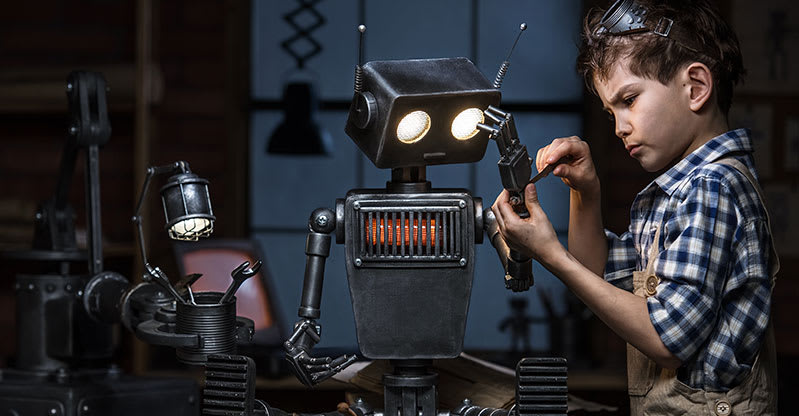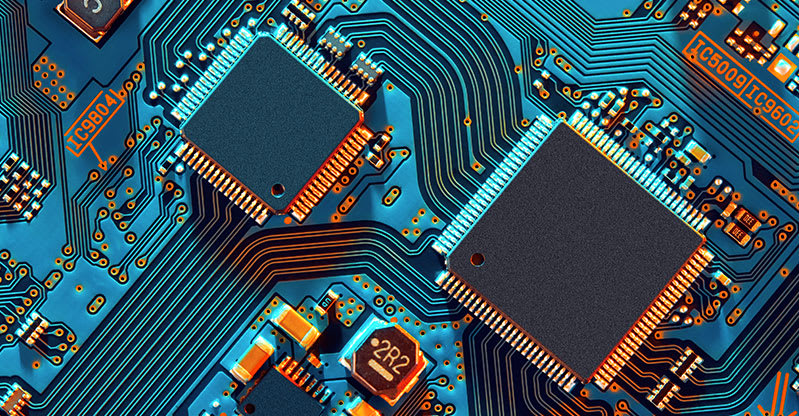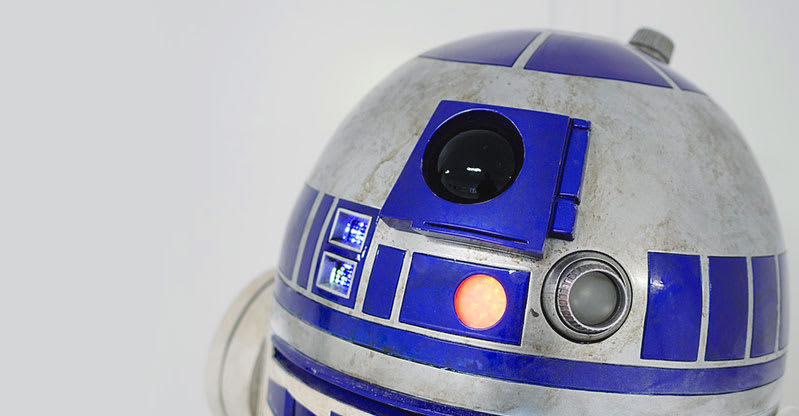One thing is for sure, children learn better when they do something with their own hands. The power of hands-on learning is amazing, and when you give your kids the possibility to experience their learning process actively, their entire relationship with learning and with discovering new tools becomes smoother and much more natural.
In order to implement this active learning approach, where hands-on activities are absolutely required, there are many things you can do. First of all, and that is what this article is all about, get some electronic kits for kids.
When we say “electronic”, please do not picture your grandfather yelling at you when you were trying to touch the plug as a baby, but instead, imagine your children building their very own computers, putting together a personalized version of the lovely R2D2, building circuits, or creating a breathtaking circuit board they saw in a digital electronics book.
In this article we are going to show you 7 electronic kits for kids, that according to our experts and to some recent research, are the best ones out there. As you already know, it is always productive to offer your kids a new challenge, and bring home a few fresh DIY electronic projects for beginners.
But, which skills can your kids strengthen while working on their snap circuits or on their soldering kits for kids? Well, electronic kits for kids and electronic projects for beginners, can help your children increase their focus and concentration, work on their mathematical thinking, understand what an algorithm is, and of course, become critical thinkers.
Before we jump into some tips on how to inspire your kids to embrace technology, and some examples of the presence of coding in our everyday lives, let’s discuss electronics a bit more, and why you should encourage your children to play and learn with an electronic kit for kids.
In only a few minutes everything will be clearer for you, and for your little ones. The electronic kits for kids we are sharing with you are proven to have worked well with many children all over the world, and they might give your kids a spectacular STEM experience, and a new appreciation for tomorrow’s world. Now, do you know what an electronic kit is? We’ll go over it in just a second…

What is an electronic kit for children?
First of all, what is an electronic kit and why is it important for our kids to own one? According to Wikipedia, an electronic kit is a package of electrical components used to build an electronic device, as simple as that. The electronic device can be a robot, a computer, or even a Hot Wheels track.
Most kits have a bunch of electronic components, a circuit diagram, a circuit board, and instructions to put everything together. And even if this is not mentioned in most places, electronic kits for kids are lots of fun, and offer multiple possibilities for your children to strengthen their 21st-century skills.
Some of the tools we are going to show you, we’ve talked about in the past, and are ideal to do some beginner electronics projects with your children and their friends. If you do so, all of your kids’ friends will want to come over to experience what it feels like to learn and have fun while using their hands on a unique, breathtaking electronic project for children.

Ways to inspire children to embrace technology
Building circuits and seeing the results of something they did on their own can definitely increase your children’s self-esteem and confidence. When your children understand that the presence of technology will be more dominant every day than the day before, they instantly comprehend how important it is to embrace it, and to actually learn how to control it.
This is an exercise we also recommend for parents. At first, think about the amount of technology your own parents had, then think about how much technology there was in the everyday items you used during your own childhood, and only then, compare it to the exposure your children have to it, and how that exposure is increasing every single day.
A nice way to inspire children to embrace technology, is to make them realize what technology is, and to compare their current lifestyle with the one we had growing up. Tell them stories about the days when cellphones were not around, or when the internet wasn’t there, and maybe even let them know that instead of heart emojis, grandpa used to send grandma love letters via traditional mail.
Here’s a good idea that has been done in the past… Show your kids a dial-up phone with a chord line, and ask them how it works. Request them to make a call, and let yourself be surprised with their reaction and answers.
Sometimes, when we are too exposed to something, we tend not to appreciate it as much. That is why, these stories and “social experiments” can help your children not take technology for granted.
Actually, the ultimate way to inspire kids to embrace technology is to give them the possibility to create it. When your children can take a technology project into their own hands, and go ahead and create their very own app, produce videos for their own YouTube channel, build a game they can share with their friends, or play with an electronic kit for children, their entire experience takes on a totally different perspective.
Let them own their learning processes by creating stuff that will leave you with your mouth wide open. Let yourself be surprised.
Now, another way to encourage your kids to love technology and do something with it, is to show them objects they use every single day that are or were programmed, and run code in order to make them work. But, what are those objects and where you can find them? Pay attention to what’s coming next.

Everyday objects that can be programmed to run code
A few weeks ago, we published an article on this subject, and we mentioned a few everyday objects that use coding or that have been programmed. Today, we invite you to think about the objects you use in your everyday life, and for a second, think about how they were built, what kind of processes were involved in their development, what kind of professionals worked on their creation, and what they looked like after their very first draft.
When we do this little exercise, and we invite out children to do it as well, we encourage them to think both deeper, and more critically, while comprehending that most of the objects they used everyday are actually coded.
Some examples
Just to give you a few examples, we could mention the following items or objects:
- TV
- Vacuum
- Laundry machine
- Computer
- Smartphone
- Speakers and headphones (they know them well from playing Fortnite)
- Oven
- Electric bikes
- Electric scooters
- Vending machines
- Traffic lights
- Ticketing station on the subway or on the bus
- Hairdryer
All of these objects, and so many others, have been coded or programmed to do a certain thing or to complete a specific task. A good way for your children to understand these processes, is to explain everything they need to know about what an algorithm is, and how its logic can be applied to the creation of almost anything, related or not to the category of technology.
Way more than just coding
But as you know (or should know) coding is way more than just writing a few lines of code and making a virtual robot turn left or right. Coding is a great way to strengthen a number of both soft and hard skills while gaining the necessary confidence to realize that anything your kids dream of, is actually possible and doable.
So, where is coding used in everyday life? And how can the children’s electronic kits we are going to show, impact the way in which they’ll face their future career paths? Let us explain a bit more about this to you, and you will start building circuits sooner rather than later.
Where is coding used in everyday life?
Let’s get directly into the point. Programming and coding are way more than just that. Coding is a way of thinking. When your kids learn to program and build their own app, or create their own game, they are facing our world and the future from a totally different perspective; an active and advantageous perspective.
So where is coding used in everyday life? Well, everywhere! Programmers are innovators, programmers are active creators of new realities, programmers are creative beings who turn an empty space into a solution that some part of society was demanding or asking for, for a very long time.
When we take a good look at the world we are living in, and understand that innovation and creativity are going to give us a huge advantage over our pairs, it should become clear that we should do something to nurture our children with skills to both innovate and be actively creative. Want to hear something? Coding will get that job done!
Again, if we think simple and we don’t go beyond the obvious, coding is in all the items and objects we mentioned before, as well as in many, many other places! But if we think critically enough, we realize that coding, and the deepest mindset of programmers, is just everywhere.
Did you know, for example, that it is a must for astronomers to know how to code? Indeed! But, why? Not only because they need it in order to manipulate the huge artifacts they work with, but also because it teaches them to think beyond the obvious. In some way, we wouldn’t have any clue of the most recent discoveries of the galaxy without coding. Sounds amazing, doesn’t it?
Now let us ask you this same question, where is coding in your life? Are you thinking differently already? Don’t you think your kids deserve a chance to think beyond and to make this world a better place? It is up to you now!
What are the best electronic kits for kids?
Pure coding can help your kids reach their full potential, but as we said at the beginning of this article, hands-on learning is just essential to climb the highest mountains, and to create those innovations that, in the future, are going to change the world.
That is why electronic kits for kids are highly recommended. We suggest you take a look at the 7 options we will show you now, and you talk about it with your children. Get to hear their own thoughts on the subjects we’ve discussed, and decide which one of these electronic projects for beginners sounds more interesting to them.
Don’t you worry if they seem sad and none of these lights a bulb, we have some other option waiting for you as a bonus. But, truly, we think at least one or two out of these eight, will make your girls and boys excited to learn with an electronic kit.
Should we jump in? Here we go!
Arduino
The Arduino projects and products are just amazing. They are experts in electronic kits for both kids and adults. As Wikipedia describes it, “Arduino is an open-source hardware and software company, project and user community that designs and manufactures single-board microcontrollers and microcontroller kits for building digital devices”.
By getting an Arduino kit, your kids will be able to experiment with hundreds of different, and very creative projects. Even building their very own robot.
Arduino’s goal is to empower the artists and scientists of tomorrow. To do that, they have kits specially designed for classrooms, and some others that are ideal to use at home. Although it is recommended that kids start using Arduino boards in middle school, you know your children better than anyone else, so if you think they’re ready before that… go for it!
If you want to understand a bit more about Arduino, this girl will do an excellent job. Take a look at this YouTube video she uploaded to her channel.
Kano Computer
We also discussed the Kano Computer when we gave you a list of the best coding toys for kids of all ages. The Kano Computer made it onto both lists, since they have a product that is just amazing.
As we said back then, this product is here to assure more kids can create a whole computer with their very own hands.
They work under the principle that anyone can build a computer, and create almost anything with it. With Kano, powered by Microsoft, your children will understand what circuits are all about, and will see with their own eyes that any idea they might have could become a reality.
Snap Circuits
With the Snap Circuits kits, your children will be able to complete and build over 300 projects. They have different kinds of electronic kits, oriented to kids of different ages. Actually, kids that are 5 years old can begin their adventure in electronics with the amazing boxes that Snap Circuits offers.
As they say themselves, their main goal and mission is to provide quality, innovative toys and educational products that are fun, engaging, and designed to install in kids, a genuine passion for learning and creating. They do this by facilitating and inspiring imagination, invention, and exploration.
Take a look at one of the many electronic projects for beginners your kids could do with Snap Circuits.
Tinkering Labs
With Tinkering Labs, your kids can build electronic powered robots that move, spin, and even doodle. Their friendly and great looking electronic kits pretend to engage your kids in STEM learning, encourage them to complete inspirational challenges, and create endless designs with parts that are 100% reusable.
As you know, we deeply believe in hands-on learning, and in the power of taking mistakes as learning experiences.
With the Tinkering Labs products, your little ones will be able to learn by manipulating motors, parts made of wood, sensors, and electronic kits for kids.
See some of the many projects your kids could make at home if they only had a Tinkering Labs kit. What do you think?
Little Bits
This is an open-source library of modular electronics, which snap together with small magnets for prototyping and learning. Their motto is, basically, to bring hardware to a place where people can look at it from an eye-level perspective, just like we do with software and printing.
They have phenomenal and colorful electronic kits for kids that, as they say, bring STEM to life and enable children to solve problems with science, while having lots of fun.
As they believe, and we do too, those who learn with these kinds of tools today, will invent the world of tomorrow. Don’t you miss these kits, and the amazing digital electronic books they have.
Take a look at the interesting things your children could do with Little Bits!
Other electronic kits for kids to take into consideration
We mentioned them in the article about STEM toys for kids, but these two -just like the Kano computer- also made it into this list, since they are also in the category of electronic kits for children.
We are talking about the amazing LEGO Boost, and the extraordinary Star Wars Droid Inventor kit. Did you ever imagine that your children could build their very own R2D2? Well, now they can do it, and they might start feeling like Luke Skywalker.
Now, if your child is Luke or Leia, you know what that turns you into, right? Come on! Give them the chance to build and own a droid.
On the other hand, the LEGO Boost is a great way to introduce digital electronics into your home, and mix it with more than just a little bit of robotics. With the LEGO Boost kit, your children will build their very own colorful and friendly robot. In order to do so, they’ll have to work and play with motors, sensors, and other electronics. Cool, right?
Give one of these electronic kits a try!

Teach your kids how to code. The time is now
To have the ultimate usage of many of these electronic kits for kids, coding is necessary. That is why, we strongly suggest you teach your children how to code. But, what would you be teaching them?
As we mentioned before, when your kids learn coding, they learn to think different, and they strengthen numerous abilities they’ll be able to use and apply in the very near future in order to build the new structures and paradigms of tomorrow’s world
But, simply put, if you enroll your kids in one of Tekkie Uni’s online, live coding classes, they’ll learn how to create their very own app, how to build a computer game from scratch, and if they are more oriented to the performing arts, they will even be able to learn how to create, edit, and upload their videos to their very own YouTube channel.
All of this, through the guidance of a well-trained instructor who will consider mistakes to be learning experiences, and will inspire them to reach the best version of themselves through creativity, critical thinking, and teamwork.
Now, what are you waiting for?




